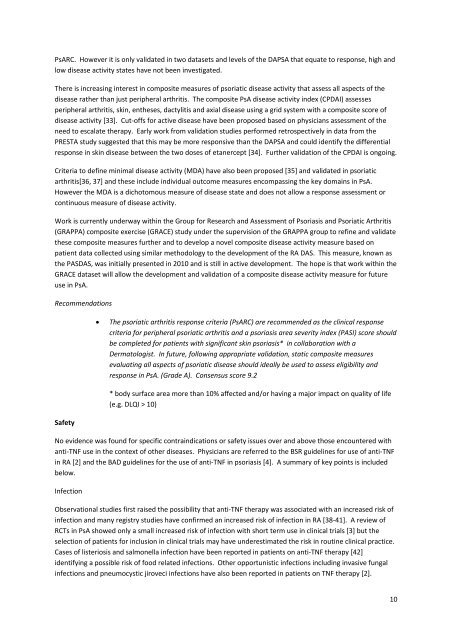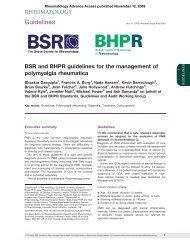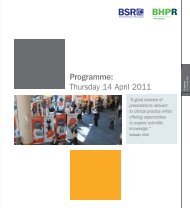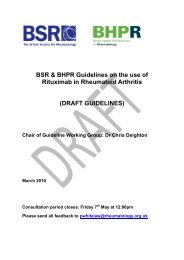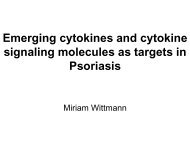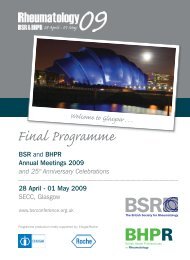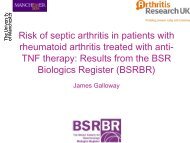Guidelines for the treatment of psoriatic arthritis with biologics
Guidelines for the treatment of psoriatic arthritis with biologics
Guidelines for the treatment of psoriatic arthritis with biologics
You also want an ePaper? Increase the reach of your titles
YUMPU automatically turns print PDFs into web optimized ePapers that Google loves.
PsARC. However it is only validated in two datasets and levels <strong>of</strong> <strong>the</strong> DAPSA that equate to response, high and<br />
low disease activity states have not been investigated.<br />
There is increasing interest in composite measures <strong>of</strong> <strong>psoriatic</strong> disease activity that assess all aspects <strong>of</strong> <strong>the</strong><br />
disease ra<strong>the</strong>r than just peripheral <strong>arthritis</strong>. The composite PsA disease activity index (CPDAI) assesses<br />
peripheral <strong>arthritis</strong>, skin, en<strong>the</strong>ses, dactylitis and axial disease using a grid system <strong>with</strong> a composite score <strong>of</strong><br />
disease activity [33]. Cut‐<strong>of</strong>fs <strong>for</strong> active disease have been proposed based on physicians assessment <strong>of</strong> <strong>the</strong><br />
need to escalate <strong>the</strong>rapy. Early work from validation studies per<strong>for</strong>med retrospectively in data from <strong>the</strong><br />
PRESTA study suggested that this may be more responsive than <strong>the</strong> DAPSA and could identify <strong>the</strong> differential<br />
response in skin disease between <strong>the</strong> two doses <strong>of</strong> etanercept [34]. Fur<strong>the</strong>r validation <strong>of</strong> <strong>the</strong> CPDAI is ongoing.<br />
Criteria to define minimal disease activity (MDA) have also been proposed [35] and validated in <strong>psoriatic</strong><br />
<strong>arthritis</strong>[36, 37] and <strong>the</strong>se include individual outcome measures encompassing <strong>the</strong> key domains in PsA.<br />
However <strong>the</strong> MDA is a dichotomous measure <strong>of</strong> disease state and does not allow a response assessment or<br />
continuous measure <strong>of</strong> disease activity.<br />
Work is currently underway <strong>with</strong>in <strong>the</strong> Group <strong>for</strong> Research and Assessment <strong>of</strong> Psoriasis and Psoriatic Arthritis<br />
(GRAPPA) composite exercise (GRACE) study under <strong>the</strong> supervision <strong>of</strong> <strong>the</strong> GRAPPA group to refine and validate<br />
<strong>the</strong>se composite measures fur<strong>the</strong>r and to develop a novel composite disease activity measure based on<br />
patient data collected using similar methodology to <strong>the</strong> development <strong>of</strong> <strong>the</strong> RA DAS. This measure, known as<br />
<strong>the</strong> PASDAS, was initially presented in 2010 and is still in active development. The hope is that work <strong>with</strong>in <strong>the</strong><br />
GRACE dataset will allow <strong>the</strong> development and validation <strong>of</strong> a composite disease activity measure <strong>for</strong> future<br />
use in PsA.<br />
Recommendations<br />
Safety<br />
• The <strong>psoriatic</strong> <strong>arthritis</strong> response criteria (PsARC) are recommended as <strong>the</strong> clinical response<br />
criteria <strong>for</strong> peripheral <strong>psoriatic</strong> <strong>arthritis</strong> and a psoriasis area severity index (PASI) score should<br />
be completed <strong>for</strong> patients <strong>with</strong> significant skin psoriasis* in collaboration <strong>with</strong> a<br />
Dermatologist. In future, following appropriate validation, static composite measures<br />
evaluating all aspects <strong>of</strong> <strong>psoriatic</strong> disease should ideally be used to assess eligibility and<br />
response in PsA. (Grade A). Consensus score 9.2<br />
* body surface area more than 10% affected and/or having a major impact on quality <strong>of</strong> life<br />
(e.g. DLQI > 10)<br />
No evidence was found <strong>for</strong> specific contraindications or safety issues over and above those encountered <strong>with</strong><br />
anti‐TNF use in <strong>the</strong> context <strong>of</strong> o<strong>the</strong>r diseases. Physicians are referred to <strong>the</strong> BSR guidelines <strong>for</strong> use <strong>of</strong> anti‐TNF<br />
in RA [2] and <strong>the</strong> BAD guidelines <strong>for</strong> <strong>the</strong> use <strong>of</strong> anti‐TNF in psoriasis [4]. A summary <strong>of</strong> key points is included<br />
below.<br />
Infection<br />
Observational studies first raised <strong>the</strong> possibility that anti‐TNF <strong>the</strong>rapy was associated <strong>with</strong> an increased risk <strong>of</strong><br />
infection and many registry studies have confirmed an increased risk <strong>of</strong> infection in RA [38‐41]. A review <strong>of</strong><br />
RCTs in PsA showed only a small increased risk <strong>of</strong> infection <strong>with</strong> short term use in clinical trials [3] but <strong>the</strong><br />
selection <strong>of</strong> patients <strong>for</strong> inclusion in clinical trials may have underestimated <strong>the</strong> risk in routine clinical practice.<br />
Cases <strong>of</strong> listeriosis and salmonella infection have been reported in patients on anti‐TNF <strong>the</strong>rapy [42]<br />
identifying a possible risk <strong>of</strong> food related infections. O<strong>the</strong>r opportunistic infections including invasive fungal<br />
infections and pneumocystic jiroveci infections have also been reported in patients on TNF <strong>the</strong>rapy [2].<br />
10


